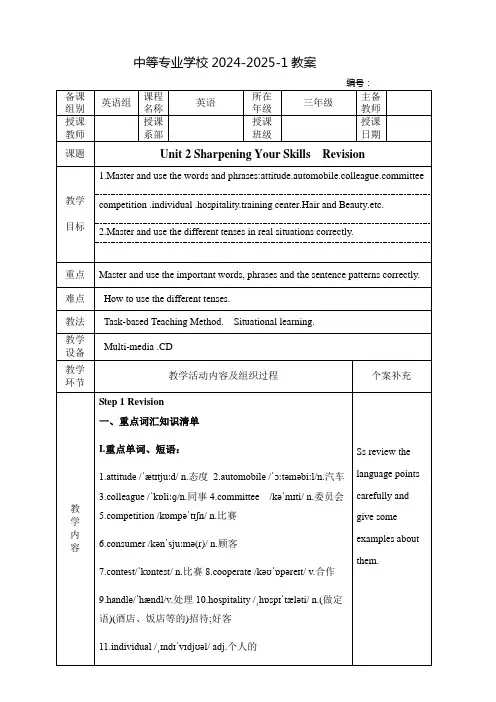中职英语拓展模块教案第十五周
- 格式:doc
- 大小:71.50 KB
- 文档页数:7
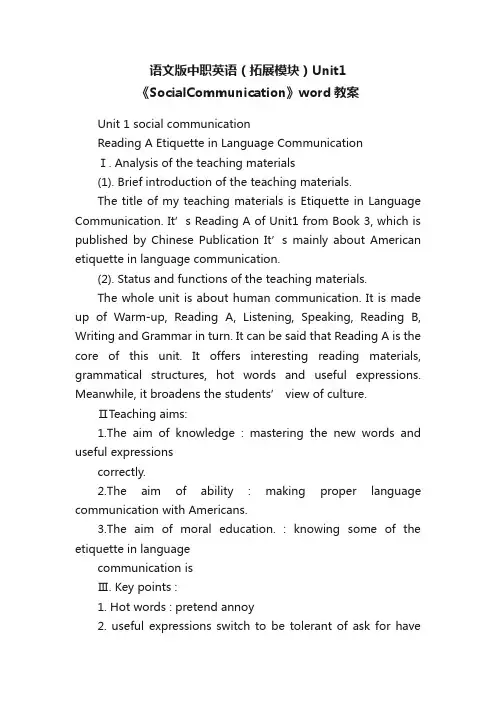
语文版中职英语(拓展模块)Unit1《SocialCommunication》word教案Unit 1 social communicationReading A Etiquette in Language CommunicationⅠ. Analysis of the teaching materials(1). Brief introduction of the teaching materials.The title of my teaching materials is Etiquette in Language Communication. It’s Reading A of Unit1 from Book 3, which is published by Chinese Publication It’s mainly about American etiquette in language communication.(2). Status and functions of the teaching materials.The whole unit is about human communication. It is made up of Warm-up, Reading A, Listening, Speaking, Reading B, Writing and Grammar in turn. It can be said that Reading A is the core of this unit. It offers interesting reading materials, grammatical structures, hot words and useful expressions. Meanwhile, it broadens the students’ view of culture.ⅡTeaching aims:1.The aim of knowledge : mastering the new words and useful expressionscorrectly.2.The aim of ability : making proper language communication with Americans.3.The aim of moral education. : knowing some of the etiquette in languagecommunication isⅢ. Key points :1. Hot words : pretend annoy2. useful expressions switch to be tolerant of ask for havetrouble (in)doing/with sth. Leave out now that3. etiquette in language communicationⅣ: Difficult points:mastering the hot words and useful expressions and putting the knowledge of etiquette in language communication into reality.Ⅴ:Conditions of the students.The students of our vocational high school are poor in fundamental English comparatively. As a result, most of them have much less interest in learning English. But they are active in taking part in activities. Their destination of studying English is to develop necessary abilities needed in their work and lives.ⅥTeaching and learning methods.1. Teaching methods:elicitation method, encouraging method, explaining method and situational method.2. learning methods :3. exploring, participating and practicing methodsⅦ: Teaching Design:carry on this lesson in six steps: lead-in, fast reading, intensive reading, practice, summary and homework, which take 2 minutes, 5 minutes, 20 minutes, 15 minutes, 2 minutes and 1 minutes respectively. Before I end this pa rt, I’d like to display my design of writing on the blackboard.ⅧTeaching procedure:Step 1 Lead in (2’)Tell a story , showing some pictures with wrong manners → Find mistakesThen ask the question: “What are wrong manners?”The students needn ’t answer t he question Step 2 fastreading (5)read fast → showing the pictures again → give their answers Then ask the question: “What we should say/do here?”× ① ×② × ③ ×④Step 3 Intensive reading (20)1. read carefully ,then ask the question: “Why should we beha ve so?”2. key words and useful expressions → long sentences → expansionKey words and expressions:ok ① ok②①② ?④ ?③③ ok ③ ok④In this step, I’ll take three steps to present the key words and useful expressions. First, the usage. Then, show one or two model sentences. Last, to get the students to participate and practise, give them one or two sentences as exercises. The exercises can be in different forms, such as, filling in blanks, translating, correcting mistakes, and so on. All the exercises are done by the students themselves.be tolerant of/towards:Usage: be tolerant of/towards +n./ pron .Model sentences:1.Mr. Smith is not very tolerant of/towards others .2.We should always be tolerant of the views of others even if we disagree with them. Exercises:1.Fill in the blank with the right form of the given words:Her own mistakes made her very____( tolerant) of/towards others.Have some/no trouble(in)…Usage: have some/no trouble(in) doing sth.Model sentences:I had some trouble (in) reading the letter . His handwriting is very bad.They had no difficulty in understanding what he said.Exercises:Translate the Chinese sentence into English:他们毫不费力就找到了我的家。
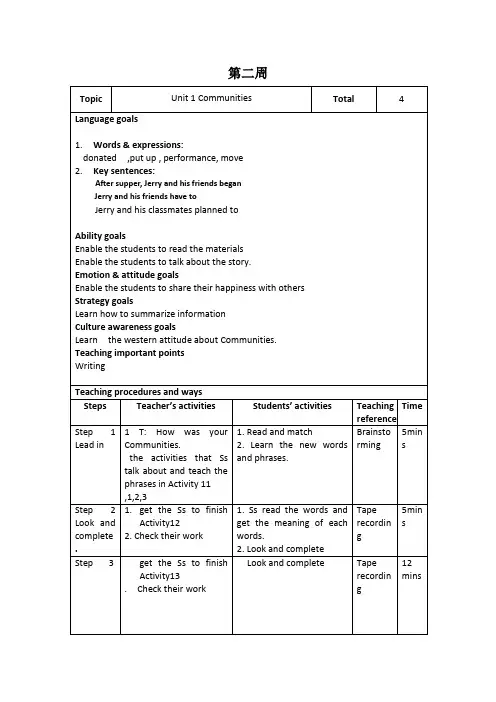

拓展模块Unit5 ExperiencesPeriod2 ReadingTeaching Aims:1)Help Ss learn some new words, such as camp/strange/be afraidof/stupid/shout/suggest etc2)Help Ss learn some useful sentences,We all felt that…We knew that…Then one of the boys suggested…We told…He doubted that…3)Help Ss understand the passage about personal experience4)Help Ss improve their reading and speaking strategies5)Let Ss cooperate with each other6)Make them share opinions with each otherTeaching Important&Difficult Points:1)How to read about a passage2)How to elicit information about personal experience3)How to talk about personal experienceTeaching Methods:Individual work, pair work, group work and task-based activities Teaching Aids:The multi-media, the tape, the BbTeaching Procedures:Step one: Lead-inShow Ss some pictures about the school trip to Shexian(歙县) last term. Ask Ss some questions:a.Do you remember the trip to Shexian?b.What do you think of the trip? Do you think it is wonderful?c.What did you do during the trip?Step Two: ReadingActivity one: Word studyHelp Ss with the new words and match the words with the meanings.ed to a. 去野营2.go camping b.愚蠢的3.once c.建议4.towards d.过去常常5.stupid e.一次6.ashamed f.想知道7.suggest g.怀疑8.creep h.羞愧的9.doubt i.慢慢的、悄悄的移动10.w onder g.对着,朝向90 Activity Two: True or false.Ask Ss to decide the following statements true or false according to thepassage.( ) 1) when I was young, I went to camping with my family every summer.( ) 2) I went camping beside a river one summer.( ) 3) One day our teacher invited a man to our camp.( ) 4) We saw a man went down to the river.( ) 5) At last we decided to find out what happened.( ) 6) We stood up and decide to find out what happened.Activity Three: Read and completeAsk Ss to complete the sentences when reading the passage.1. We all felt a. that we had seen the man2. We know b. what I saw that day.3.The one of the boys suggested c.we should go and see what theman was doing4.We told the teacher d. this man looked very strange5.He doubted e. what had happened in the evening6. I still wondered f. that he only return by passingthrough the campActivity Four: work in pairs.Let Ss work in pairs to find out the answers.1.What did we see when we were having supper?2.Why we did not say anything about the man who looked strange?3.What surprised us very much?Activity Five: Discuss and complete.Ask Ss to discuss with the partner to complete the summary of the passage.I went to camp with my teacher and classmates this summer. We met something quite strange this time and I believed I would never forget it. One afternoon, when we were having our suppe r we saw a man passingand going towards the river. Atfirst,nobody said anything aboutthis,because no one wanted to belooked as stupid.Then no one daredto walk when we had to wash thedishes in the river.At last, wedecided to find out what the manwas doing. When we walked down tothe bank, we found no one on thebank. This surprised us very much,because the man could only returnby passing our camp and no one hadseen the man leaving.Step Three: Summary and homework1.Ask Ss to describe their own experiences and share withtheir classmates.2.Preview the lesson.教学反思:今天是一堂典型的阅读课。
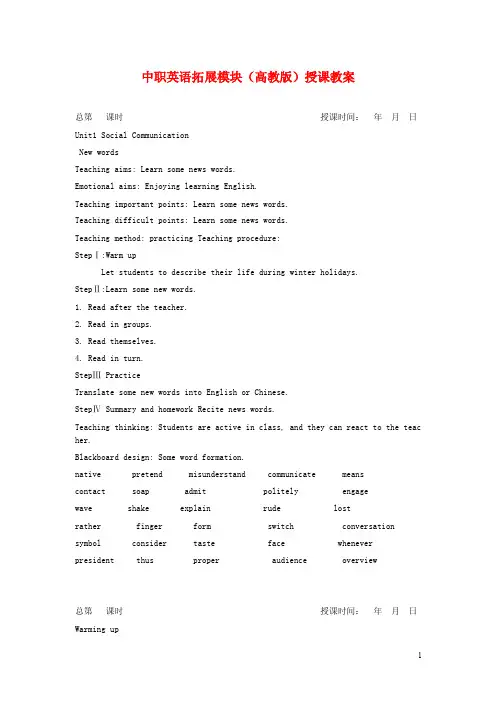
中职英语拓展模块(高教版)授课教案总第课时授课时间:年月日Unit1 Social CommunicationNew wordsTeaching aims: Learn some news words.Emotional aims: Enjoying learning English.Teaching important points: Learn some news words.Teaching difficult points: Learn some news words.Teaching method: practicing Teaching procedure:StepⅠ:Warm upLet students to describe their life during winter holidays.StepⅡ:Learn some new words.1. Read after the teacher.2. Read in groups.3. Read themselves.4. Read in turn.StepⅢ PracticeTranslate some new words into English or Chinese.StepⅣ Summary and homework Recite news words.Teaching thinking: Students are active in class, and they can react to the teac her.Blackboard design: Some word formation.native pretend misunderstand communicate meanscontact soap admit politely engagewave shake explain rude lostrather finger form switch conversation symbol consider taste face whenever president thus proper audience overview总第课时授课时间:年月日Warming upTeaching aims: Learn some news words.Emotional aims: Learn some manners in language communication.Teaching important points: Discuss some questions.Teaching difficult points: Learn some news words.Teaching method: practicing and discussing.Teaching procedure: StepⅠRevisionReview some words.StepⅡ Discussion 讨论课文插图Now look at the picture in the reading text "Etiquette in Language Communic ation".What can you see in it?-From the picture, we can see a woman is talking with a man. But the manlooks a bit uneasy, maybe he is nervous. Obviously it's not a smooth language c ommunication.StepⅢ提示相关生词和短语,如:native speaker, native language, have trouble in doing sth, pretend to do sth, repeat, explain, manner等。
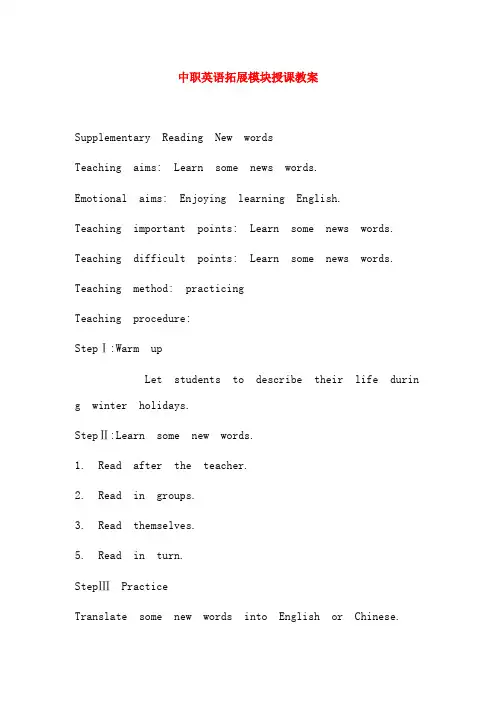
中职英语拓展模块授课教案Supplementary Reading New wordsTeaching aims: Learn some news words.Emotional aims: Enjoying learning English.Teaching important points: Learn some news words. Teaching difficult points: Learn some news words. Teaching method: practicingTeaching procedure:StepⅠ:Warm upLet students to describe their life durin g winter holidays.StepⅡ:Learn some new words.1. Read after the teacher.2. Read in groups.3. Read themselves.5. Read in turn.StepⅢPracticeTranslate some new words into English or Chinese.StepⅣSummary and homework Recite news words. Teaching thinking: Students are active in class, and they can react to the teacher.Blackboard design: Some word formation.Supplementary ReadingTeaching aims: 理解文章的基本内容Emotional aims:克服学习中的困难Teaching important points: 掌握教学目标中的Key words和useful Expressions的基本用法Teaching difficult points: 掌握教学目标中的Key words和useful Expressions的基本用法Teaching method: practicing and reading.Teaching procedure:StepⅠRevisionReview some words.StepⅡReading1. Read the text carefully in a few minutes discuss in groups and answer in turn.2. Answer the following questions.What is the body language/nonverbal communication? StepⅢKey words和Useful Expressions①We commumcate with each other by means of language.我们通过语言相互交流。

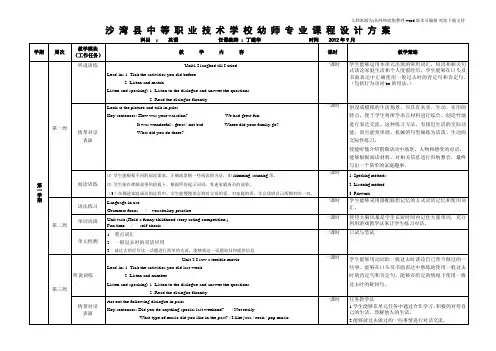
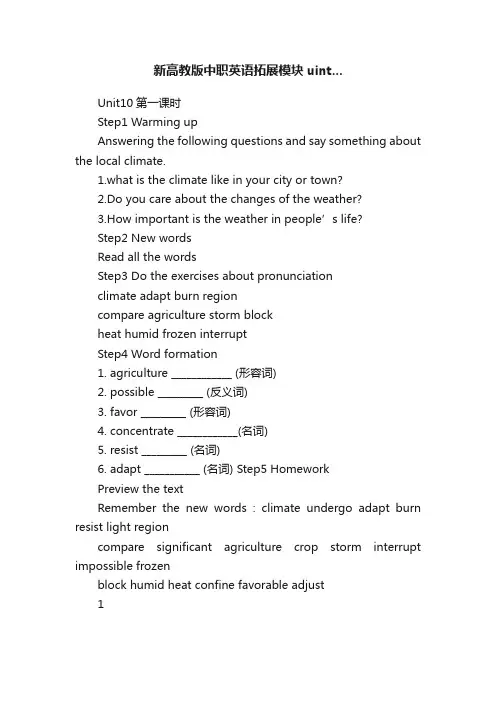
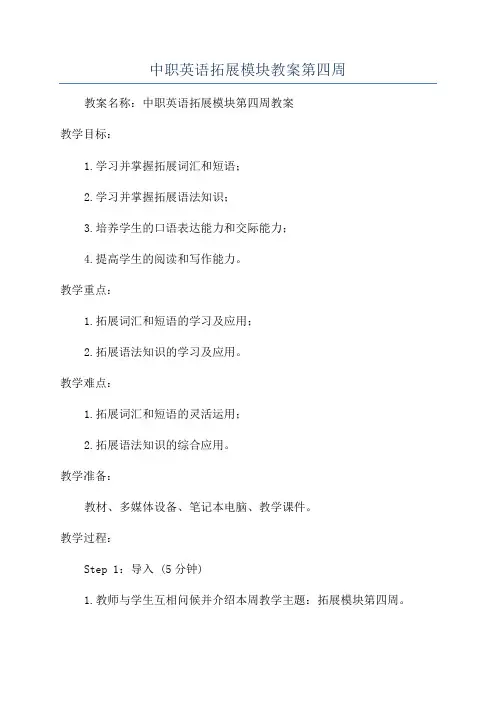
中职英语拓展模块教案第四周教案名称:中职英语拓展模块第四周教案教学目标:1.学习并掌握拓展词汇和短语;2.学习并掌握拓展语法知识;3.培养学生的口语表达能力和交际能力;4.提高学生的阅读和写作能力。
教学重点:1.拓展词汇和短语的学习及应用;2.拓展语法知识的学习及应用。
教学难点:1.拓展词汇和短语的灵活运用;2.拓展语法知识的综合应用。
教学准备:教材、多媒体设备、笔记本电脑、教学课件。
教学过程:Step 1:导入 (5分钟)1.教师与学生互相问候并介绍本周教学主题:拓展模块第四周。
2.分享一段关于拓展词汇和短语的视频,并与学生一起回顾上周的教学内容。
Step 2:词汇与短语学习 (15分钟)1.教师通过多媒体展示本周所学词汇和短语,并详细解释其意思和用法。
2.教师提供例句并要求学生进行模仿并造句。
Step 3:语法知识学习 (20分钟)1.教师通过多媒体展示本周所学语法知识,并进行讲解。
2.教师提供例句并要求学生进行模仿并造句。
Step 4:口语训练 (15分钟)1.教师以班级分组形式进行口语对话练习,每组选择一位组长并给予一个主题。
2.组长在一分钟内让组员们就该主题展开对话,并教师进行点评和指导。
Step 5:阅读与写作训练 (20分钟)1.教师提供一篇关于拓展词汇和短语的短文,要求学生阅读并理解文章内容。
2.学生根据所学词汇和短语,完成一篇关于自己的文章,并与同桌进行互评和修改。
Step 6:小结与作业布置 (5分钟)1.教师进行本节课内容的小结,并与学生进行互动讨论。
2.布置下节课的作业,要求学生根据所学知识完成一篇关于生活习惯的作文。
Step 7:课堂延伸 (5分钟)1.教师安排学生进行一个小组竞赛游戏,游戏内容为拼写所学词汇和短语。
2.游戏结束后,教师对学生表现进行点评,并颁发奖励。
Step 8:课堂分享 (5分钟)学生坐回座位,教师将学生的作文进行汇总整理,并选取几篇优秀的作文进行课堂分享。
